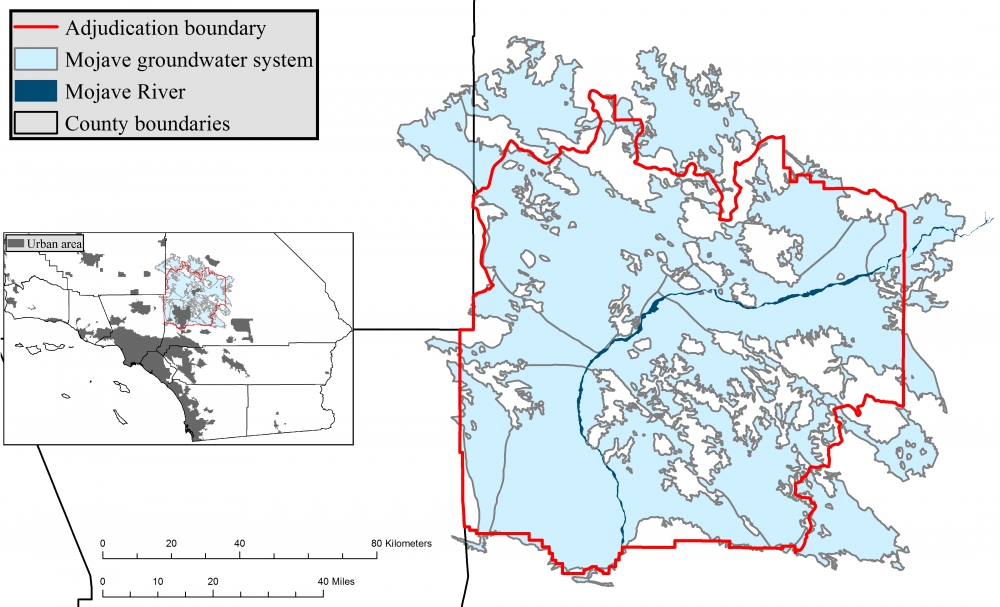
A System for Success



Amid historic drought and changing rainfall patterns, a groundwater market in the California desert could serve as a template for the future of water management.
When landowners overlying the Mojave groundwater system switched from open-access management to a cap-and-trade system, it helped stabilize their groundwater resources. Researchers at UC Santa Barbara’s Bren School of Environmental Science & Management and the Public Policy Institute of California were curious about the market’s other impacts. Their new study reveals that the switch also increased the values of properties within the groundwater market, even though the system restricted the amount of groundwater that landowners could pump. These benefits were over 10 times the initial cost of establishing the market.
These promising findings, published in the prestigious Journal of Political Economy, come as many other communities begin to develop their own management strategies under California’s new Sustainable Groundwater Management Act.
“The groundwater problem is actually a very old problem,” said co-author Kyle Meng, an associate professor of environmental economics at the Bren School. “It’s a classic case of the tragedy of the commons: No one owns groundwater, and because no one owns it, there’s a race to extract it.” This race to pump incentivized an inefficient, short-sighted approach to water use, he added.
Although the Mojave is the driest desert in North America, farmers have historically grown water-intensive crops like alfalfa by drawing upon an underlying groundwater basin, or aquifer. However, between 1960 and 1990 pumping from this basin had depleted the resource to such an extent that water tables had fallen by 30 feet, spelling trouble for everyone involved.
In 1996, stakeholders finalized a cap-and trade market spanning the majority of the Mojave groundwater system. The market limited the amount of pumping, but allowed landowners to trade their rights with other users within their trading area.
The system successfully stabilized the aquifer, but Meng and his co-authors, Andrew Plantinga and Andrew Ayres, sought to determine if this change also provided financial benefits. To this end, they developed a mathematical model to formalize groundwater use and human behavior before versus after the market’s implementation. “Understanding it conceptually allows us then to know what we’re actually measuring when we look at the data,” said Professor Plantinga, a resource economist at the Bren School.
The researchers then compared property values between parcels on either side of the market’s boundary. In this case, the extent of the aquifer was slightly different than the bounds of the water market. By comparing properties within the same groundwater system, but governed by different regulations, the team could avoid introducing confounding factors that arise when comparing between different basins.

Differences between the Mojave groundwater basin and the adjudication boundary enabled the team to set up a rigorous comparison.
Photo Credit: AYRES ET AL.
The authors found that the values of properties within the market increased by over 200% on average. Altogether, the market contributed a net benefit of at least $400 million (in 2015 dollars) to agricultural and urban users.
In contrast, the administrative and legal costs of setting up the system was a mere $40 million in 2015 dollars. In fact, the authors claim their figures are likely an underestimate of the market’s benefits, as they didn’t account for the value of the additional groundwater.
But why would properties within the market be worth more than those with free rein to pump?
The answer is all about for whom the water has value. Previously, landowners could only pump for their own use on their own lands; the water didn’t hold any external value. But the cap-and-trade system enables participants to sell or lease their pumping rights, potentially for a higher value than any use the extra water could be put to on site.
This allows water to be used in more valuable ways while simultaneously compensating the original owner. Farmers with less productive fields can now sell water rights to their more productive neighbors, or even to local cities, which are often willing to pay quite a bit for it.
“The cap-and-trade market both restricts users and gives them more freedom at the same time,” said Meng. The “cap” restricts the amount of water a user can withdraw, but the “trade” enables a user to sell their rights, which wasn’t possible before.
The concept of environmental markets is not new. They govern around a third of global fisheries and a tenth of carbon emissions, according to the authors: “However, determining whether these pervasive policies actually deliver on their promises has been elusive,” Plantinga said.
“Even though the idea of an environmental market has been around since the ‘60s, this is, to our knowledge, the first paper that quantifies the net benefits of an environmental market,” Meng added.
That said, environmental markets aren’t guaranteed to generate net benefits. They work theoretically, but under a lot of assumptions that won’t always hold true in the real world. For instance, a cap that’s too tight might negate any benefits from the trading aspect of a cap-and-trade system.
The authors approached this study with no presumption that a market would be better than any other intervention. They were excited that even in the messy real world, the Mojave groundwater market worked splendidly.
This is good news for stakeholders, who will need effective groundwater management strategies for some tough decisions ahead. In 2014, California passed the Sustainable Groundwater Management Act (SGMA) to address dwindling groundwater resources in basins across the state.
“Areas that may have been over-drafted in the past — but perhaps not to the extent where the users were motivated or able to resolve the problem — are now going to be prompted to do that,” said co-author Ayres, a former UCSB doctoral student now at the Public Policy Institute of California. As result, groundwater markets have become increasingly attractive.
Groundwater management is very localized under SGMA; communities in each basin must determine how they will achieve the requirements set out by the legislation. That said, there are really only two options for approaching the task: increase the supply through groundwater recharge and/or decrease the demand from pumping.
There are only a few ways to actually make these decisions. The benefit of a groundwater market is that it gives more autonomy directly to the stakeholders rather than to, say, a centralized administration. The local agency certainly exercises centralized authority — determining aspects like the cap, allocating pumping entitlements and enforcing compliance — but the increased stakeholder autonomy builds upon SGMA’s inherently decentralized nature.
What’s more, under a groundwater market, the people reducing their use get compensated for participating in a system that ultimately solves the problem. “It is a mechanism for getting people on board who might otherwise try to impede the process,” said Ayres.
Several communities have already begun implementing groundwater markets. The Fox Canyon Groundwater Management Agency’s fledgling water market in Ventura County has been heralded as SGMA's first groundwater market. Meanwhile, pumpers in the Borrego sub-basin, in eastern San Diego County, reached an agreement in early 2021 on a new system that includes a market. Interest is growing in many other basins as well.
As promising as these results are, the authors acknowledged that their study didn’t consider how a water market’s benefits are distributed. Environmental markets can help improve efficiency, Meng said, but they don’t necessarily reduce economic disparities. In the future it may be worthwhile to incorporate an equity component into these systems.
“We are increasingly looking at these kinds of distributional questions for a variety of environmental markets,” Plantinga said.



